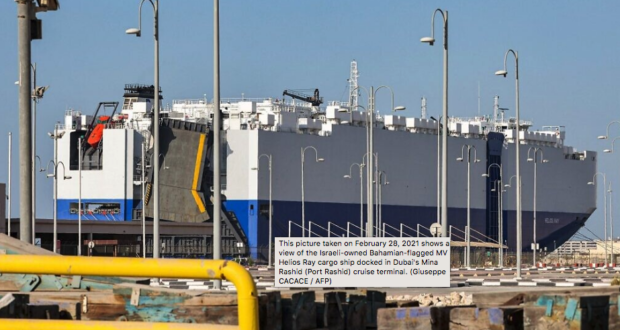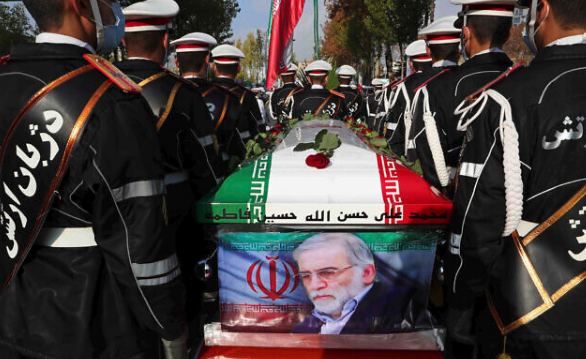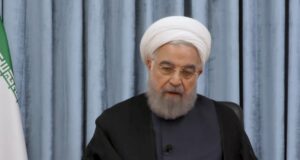Lazar Berman
By LAZAR BERMAN
4 March 2021, 6:38 am 0
292
shares
This picture taken on February 28, 2021 shows a view of the Israeli-owned Bahamian-flagged MV Helios Ray cargo ship docked in Dubai’s Mina Rashid (Port Rashid) cruise terminal. (Giuseppe CACACE / AFP)
This picture taken on February 28, 2021 shows a view of the Israeli-owned Bahamian-flagged MV Helios Ray cargo ship docked in Dubai’s Mina Rashid (Port Rashid) cruise terminal. (Giuseppe CACACE / AFP)
The alleged Iranian attack on an Israeli-owned vessel over the weekend might seem like the stuff of spy movies, but it fits in entirely with Iran’s modus operandi and national interests.
On Friday, a blast struck the Israeli-owned MV Helios Ray, a Bahamian-flagged cargo ship, in the Gulf of Oman.
The explosion reportedly punched two holes in the vessel’s port side and two on its starboard side, just above the waterline.
Get The Times of Israel’s Daily Edition by email and never miss our top storiesFREE SIGN UP
Prime Minister Benjamin Netanyahu accused Israel’s regional foe Iran of attacking the ship. Iran swiftly denied the charge, but experts say the attack bears hallmarks of previous attacks ascribed to Tehran.
The Israeli-owned Bahamian-flagged MV Helios Ray cargo ship docked in Dubai’s Mina Rashid (Port Rashid) cruise terminal, February 28, 2021. (Giuseppe Cacace/AFP)
“It kind of walks like a duck and quacks like a duck,” said Michael Eisenstadt, director of the Military and Security Studies Program at the Washington Institute for Near East Policy.
“They were successful, at least tactically, with their limpet mine operations in May and June 2019. So the modus operandi they are comfortable with is in their backyard now, and the Israelis find it very difficult to defend all their maritime traffic around the world,” he said.
The operation seems to have been carefully planned, and mirrored a series of attacks on tankers in 2019 and an Iranian campaign against shipping vessels four decades ago. It caused some physical damage to the ship, but did not cause any deaths or sink the vessel, avoiding unwanted escalation.
Tehran is desperate to respond to a series of military setbacks. Senior Iranian nuclear scientist Mohsen Fakhrizadeh was traveling on a highway outside the capital in November 2020 when he was killed by what was reported as a remote-controlled machine gun. The assassination came after months of mysterious explosions in Iran, including a blast and fire that crippled an advanced centrifuge assembly plant at the Natanz uranium enrichment facility, which is widely believed to have been an act of sabotage allegedly carried out by Israel.
Military personnel stand near the flag-draped coffin of Mohsen Fakhrizadeh, an assassinated top nuclear scientist, during his funeral ceremony in Tehran, Iran, November 30, 2020. (Iranian Defense Ministry via AP)
In addition, Iran remains under crippling US sanctions that it is desperate to find a way out of.
While Syria is consumed by a decade-long civil war, Iran has been trying to open a new front on Israel’s border. It has sent allied forces to the Syrian Golan Heights to set up infrastructure for carrying out attacks on Israeli targets. Iran has also been working to arm its Hezbollah proxy terrorist group with precision rocket capabilities, shipping weapons through Syria to Lebanon.
However, Israel has displayed competence in sniffing out Iranian actions and a firm willingness to disrupt them using military force. A January 2015 strike on a convoy near Quneitra killed an Iranian general and senior Hezbollah commanders, including the son of Imad Mughniyeh, a senior Hezbollah commander killed in Damascus in 2008. Israel’s air force has launched hundreds, even thousands, of strikes against Iran and its proxies in Syria and Iraq since 2011.
“This fits in with Iran being frustrated in its efforts to get at Israel from Syria, where Israel dominates, now acting in their own backyard against Israel because, first of all, it’s a proven modus operandi,” said Eisenstadt.
The Panama-flagged, Japanese-owned oil tanker Kokuka Courageous that the US Navy says was damaged by a limpet mine, is anchored off Fujairah, United Arab Emirates, during a trip organized by the Navy for journalists, Wednesday, June 19, 2019. The limpet mines used to attack the oil tanker near the Strait of Hormuz bore “a striking resemblance” to similar mines displayed by Iran, a U.S. Navy explosives expert said Wednesday. Iran has denied being involved. (AP Photo/Fay Abuelgasim)
The damage suffered by the Helios Ray is consistent with an attack using a limpet mine, easily attained explosive devices affixed magnetically to ships by combat divers or combat engineers on small boats. They are placed just above or below the waterline, and are meant to knock ships out of action temporarily, not to sink them.
Limpet mines were seemingly used in a series of attacks on tankers in the Gulf of Oman in mid-2019. On May 12, 2019, four ships in the Port of Fujairah were sabotaged by attackers using the mines. A month later, a Japanese and a Norwegian oil tanker were both attacked with suspected limpet mines. The US and others blamed the attacks on Iran, which denied any involvement.
“The problem with the limpet mine is that almost anyone can acquire and use one,” said Anthony Cordesman, the Arleigh A. Burke Chair in Strategy at the Center for Strategic and International Studies. “If you fire an anti-ship missile, you can detect exactly who fired it and the exact platform that fired it.”
Limpet mines, however, are not clearly traceable.
An attack that makes attribution difficult “creates ambiguity that serves Iran’s interests,” said Cordesman. “If you can use gray zone operations to achieve your objectives without escalating to more serious conflict, these kinds of operations offer you advantages and a level of security that higher intensity combat doesn’t. And Iran has practiced a very wide range of attacks.”
“Gray zone operations” are coercive, ambiguous actions taken by actors trying to upend the regional order while staying below the threshold that would justify a military response by stronger parties. NATO militaries have increasingly recognized them as a challenge.
Experts believe the gray zone approach is a central component of Iran’s national security strategy. Deniable attacks on civilian shipping fit into Iran’s broader, asymmetric naval strategy.
An oil tanker on fire in the Gulf of Oman, June 13, 2019 near the strategic Strait of Hormuz where two ships were reportedly attacked. (AP Photo/ISNA)
Iran has targeted civilian shipping since the early years of the Islamic Republic. Its location on the Strait of Hormuz gives it a measure of control over one of the world’s most important shipping chokepoints. Only 21 miles wide at its narrowest point, with shipping lanes only two miles wide, the Strait of Hormuz sees the equivalent of nearly a quarter of the world’s daily petroleum liquids consumption sail through its waters every day.
By flexing its ability to wreak havoc in the vital sea lane, Tehran is able to threaten the flow of oil from major producers like Saudi Arabia, the United Arab Emirates, Kuwait and Iraq.
During the brutal Iran-Iraq War in the 1980s, Iran targeted oil tankers and platforms throughout the Persian Gulf in an attempt to damage Iraq’s economy, in what would come to be known as the Tanker War. It was a desperate move, a sign that Iran realized it could not defeat Iraq on the battlefield.
The Singapore registered tanker “Norman Atlantic” sits ablaze in the Straits of Hormuz on Dec. 6, 1987, after being attacked by an Iranian gunboat. (AP)
In 1987, the US decided to reflag tankers from other countries as American and escort them through the threatened region. Iran used a range of weapons against the ships, including advanced missiles and moored contact mines. The low-boil conflict between Iran and the US saw Iranian ships sunk and the US accidentally down an Iranian civilian jet.
Iran learned from the experience that it cannot stand toe to toe — or hull to hull in this case — with the US in a conventional naval conflict. It instead developed a range of capabilities for asymmetrical naval warfare.
“It doesn’t just focus on one kind of attack,” Cordesman stressed. “It practices low- level attacks… It escalates to land-based anti-ship missiles. It conducts a mixture of attacks on shipping from platforms like drones, they use or at least encourage groups like the Houthis to use land-based missile attacks in sequence, or simultaneously with naval attacks. So this is not some kind of simplistic model. Effectively you’re talking about a country that knows how to play three-dimensional chess.”
Tehran has targeted oil tankers in the ensuing years and regularly threatens to shut down the Strait of Hormuz in response to Western pressure.
The IRGC seized a British tanker in July 2019 after surrounding it with attack boats and rappelling onto its deck. The ship’s seizure was widely seen as a tit-for-tat move after authorities in the British overseas territory of Gibraltar detained an Iranian tanker on suspicion it was shipping oil to Syria in breach of EU sanctions.
A picture taken on July 21, 2019, shows Iranian Revolutionary Guards patrolling around the British-flagged tanker Stena Impero as it’s anchored off the Iranian port city of Bandar Abbas. (Hasan Shirvani / MIZAN NEWS AGENCY / AFP)
In January, IRGC naval forces seized a South Korean oil tanker and held its crew for a month, allegedly over environmental violations. The incident was described by experts as a pressure tactic meant to induce Seoul to release billions of dollars of Iranian assets it holds as the result of US sanctions.
However, Iran’s attacks on and seizures of oil tankers belonging to Japan, South Korea and the UK infuriated important international players.
“A lot of countries still depend on oil, especially in Asia, and no one likes when ships start getting mined,” Eisenstadt pointed out. “That’s when they realized that it kind of backfired on them. They didn’t get the response from the US in terms of easing or lifting sanctions. And it put them in a bad place with regard to important countries that still depend on oil.”
The Helios Ray attack, by contrast, was not on an oil tanker from a potentially friendly country, but rather on an Israeli shipping vessel, and may have been intended to send a message to Israel and the world.
“The Iranian Revolutionary Guards Corps tries to undermine stability in the region,” said Erfan Fard, who researches counter-terrorism in the Middle East. “It wants to the show that it is the hegemon and there cannot be stability without it.”
It is also a signal to Israel that Iran wants it out of its backyard, said Fard.
This image released Thursday, Jan. 14, 2021, by the Iranian Army shows a helicopter hovering over the Iranian-made Makran logistics vessel during a naval drill. (Iranian Army via AP)
Iran has invested heavily in pursuing hegemony over the sea in its neighborhood. It has short, medium and long-range coastal anti-ship missiles, including the domestically produced Khalij Fars missile. Tehran has bought and produced submarines armed with long-range torpedoes. On the surface, the regular navy has a relatively robust fleet armed with anti-ship missiles. Its IRGC counterpart has invested in suicide speedboats and fast-attack craft to overwhelm enemy warships with swarm tactics. It can also target ships with UAVs, special forces raids and proxy forces throughout the region.
These elements are on display in Iran’s naval exercises. “Some involve amphibious elements, commando raids, strikes on islands, or platforms like drones,” said Cordesman. “Some involve the use of swarming tactics, others involve the use of remote-controlled surface vessels armed with explosives.”
Fishing for a solution
A centerpiece of Israel’s normalization with the Gulf states was increased trade, especially with the global shipping hub of Dubai. Given Tehran’s predilection for deniable attacks on civilian targets, its experience in carrying out such operations, and the capabilities it has developed to do so, Israel will need to find a way to protect its shipping interests.
One option may be a strategy of deterrence by hitting back. Israel and Iran have been involved in a low-level tit-for-tat war for years, with cyberattacks on infrastructure and other soft targets. On Wednesday, Environmental Protection Minister Gila Gamliel blamed Iran for an oil spill that has dirtied Israel’s coasts, possibly previewing a new maritime front being opened between the countries.
Israel could send its own message by targeting an Iranian ship in the Red Sea, such as the Saviz, called a “mothership” by the Washington Institute for Near East Policy. Though it is officially a civilian cargo ship, since 2017 the Saudis have alleged the Saviz served as a maritime base and weapons transshipment point for the IRGC.
Putting Israeli forces on ships plying the Persian Gulf may seem like an option, but Jerusalem may have a hard time projecting power so far from home.
Israel could put its own forces on civilian ships, but they could be overwhelmed by Iranian troops operating close to their home bases. “Right now you have crews that are not Israeli. Do you really want to put Israelis on board and then have the potential of having prisoners in Iran’s hands?” asked Eisenstadt.
In December, reports surfaced that Israel had sent a submarine through the Suez Canal and toward the Persian Gulf, in a message to Iran. But it makes no sense for Israel to try to project military power into the Persian Gulf, Cordesman pointed out.
Rather, he suggested a joint effort not unlike a short-lived 2019 plan for a US-led naval coalition to protect the shipping lanes.
“There are several options Israel has,” he said. “One is seeking assistance from the United States, seeking some kind of broader guarantees that could involve not only the US but some of the Arab Gulf states to secure its shipping.”








